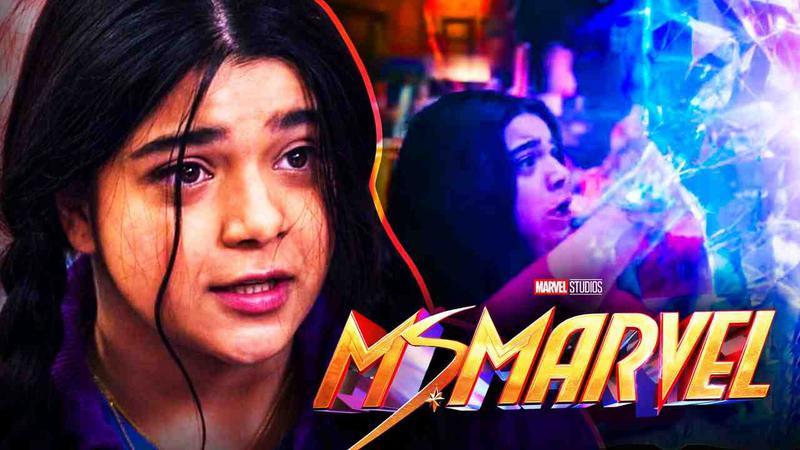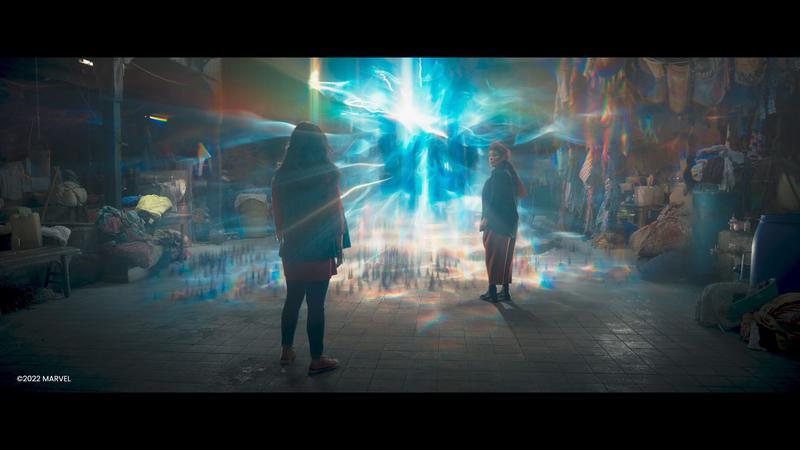
Disney+ has allowed the MCU to fully expand its story from purely cinematic adventures to more serialized, episodic additions over the past couple of years.
While this allows the franchise to become even more connected by using actors from the big-screen movies for epic crossover events in its shows, there are new challenges that stem from bringing the MCU to a TV-style setting. This largely comes from a behind-the-scenes standpoint, with a budget and production timeframe that usually pale in comparison to what Marvel Studios' movie counterparts are allowed.
Some of that dichotomy was seen most recently in Ms. Marvel, with directors Adil El Arbi and Bilall Fallah even teasing some visual moments that had to be cut from a couple of big episodes in an exclusive chat with The Direct. We also had a chance to speak with one of the show's head VFX supervisors, who shared some insight into one of Ms. Marvel's biggest VFX moments from the show's penultimate episode.
Crazier VFX In a Ms. Marvel Movie?

In an exclusive interview with The Direct's Richard Nebens, Ms. Marvel VFX Supervisor Kevin Yuille of FuseFX discussed the work that went into the Veil from Episode 5 and how it would have been even crazier in a theatrical movie.
Yuille revealed that his company, FuseFX, was actually one of the last teams to complete the VFX work on the Veil, noting how they were on "a pretty tight schedule" and that the effect wasn't "where Marvel landed on what they really wanted to see" at the time:
"So, FuseFX, we kind of joined at the end, it had been in production for a long time. So long that some of the vendors, you know, because there were reshoots and such, they couldn’t stay on the show. They were like, ‘We don’t have the resources, we gotta move on.’ So we kind of picked up where some others had left off on that sequence specifically, but we had a pretty tight schedule. There was a lot of legwork done before us, some other companies had some really cool looks for early versions of this Veil, but of course, that’s not where Marvel landed on what they really wanted to see."

He looked back to earlier versions that looked "a little more like colorful fire," leading the team to adjust their idea for how the Veil would look in the end. They settled on something that looked "more fabric-y" with the name being "the Veil," opting to go more literal on the interpretation:
"So, early versions were a bit more of like a pyro sim, a little more like colorful fire. It was pretty detailed, but it looked too much like fire, something that people would I think say ’Is that fire that I’m seeing?’ They wanted it to not look like fire. So going through many, many iterations of that, we came to the conclusion ‘OK, we have to pivot and change how we’re doing it.’ So really, you want to create light that is pooling out of a hole. It’s almost like fabric. The name is ‘the Veil,’ so it’s kind of like ‘OK, maybe we should be literal and kind of go more with almost sheets of light coming out.’ If you look, it looks more fabric-y, it has flow and curls and it flaps and stuff like that. And then when it gets angry, it shoots tentacles of light, they even have fabric qualities to it. So I think that was a moment where we’re like ‘OK, cool, we have something that is different.’ It was pretty unique."
The Veil was made up of "30 to 40 renders put together," leading him to compare the effect to how it would have been done in a movie.

In that instance, the entire environment would have been completely destroyed with the ground and surroundings ripping apart, although the project's nature as a TV show didn't allow for the time needed to complete that. Instead, FuseFX used "a lot of interactive lighting passes" so that the entire setting could be seen, with the Veil being broken up into multiple layers along the way:
"So, in terms of the number of elements…boy, it was very layered. When the Veil got really big, you’re probably looking at…I’d have to say 30 or 40 renders put together, different passes that comp is using to shift colors. The environment, for example, time was an issue. Had this been a feature film, they would have destroyed that environment. You would’ve seen stuff ripping on the ground, it would have been crazy, but given the time, we had to do a lot of stuff in comp, so there was a lot of special passes to make the ground kind of distort and get spiky. We had a lot of interactive lighting passes so, if the Veil is lighting up, you could light up another part of the room. The Veil itself, we had a core, and the core had several renders, and you had this inner Veil that kind of connected to the core, and then an outer Veil, and then these…we call the ‘reachers,’ those things that shoot out. It was a pretty big script."
This turned out to be one of the biggest effects that Yuille had ever worked on, which was only made more difficult by the tight schedule and turnaround in which it had to be completed:
"We used a program called Nuke for compositing, and those were big, big scripts, they were very heavy. Doing all those light effects where you get these streaks and the color separation, that was all treatments in comp. It was one of the bigger effects that I’ve worked on at Fuse, compounded by the schedule and whatnot. I’d be lying if I said it wasn’t stressful, but we got through it, and the result was pretty good."
Marvel Working Through TV Limitations on Ms. Marvel
Fans have learned over the past few years how big the differences are between making a movie within the MCU and making an episodic show on Disney+. And while some are worried about the working conditions that Marvel's VFX artists have to endure to complete these shows, the team does the best job possible to make sure that the Disney+ stories still have visual effects good enough to stand up to the movies.
Seeing as Yuille's work with FuseFX came late in production for Ms. Marvel, his team only got to work with what had already been established from a visual standpoint.
With a movie, he and his team would have broken everything down to the base during a scene like the Veil's opening in Episode 5, using heavy visual effects on everything that could possibly be seen on camera during that moment. This would have been possible with the extended timeframe that can be used for the MCU's movies, particularly as they're announced years ahead of when they actually release on the big screen.
Even though VFX artists are still worried about what kind of workload will come with everything on the way in Phase 5 and Phase 6, Marvel continues improving its techniques as new projects make their way to theaters and Disney+. Ms. Marvel should be able to make improvements of its own should a second season be ordered, and fans will see even more improvements upon Kamala Khan's return in The Marvels as well.
All six episodes of Ms. Marvel are available to stream on Disney+.
Richard Nebens joined The Direct in March 2020, now serving as the site's Senior Writer and also working as an assistant editor and content creator. He started his journalism career as a hobby in 2019 and is passionate about sharing news and stories from the entertainment industry, especially comic book movies, comedy, and sci-fi. Richard looks to expand his knowledge about movies and TV every day, and he is eager to stay locked into the latest releases and breaking news at every opportunity.












